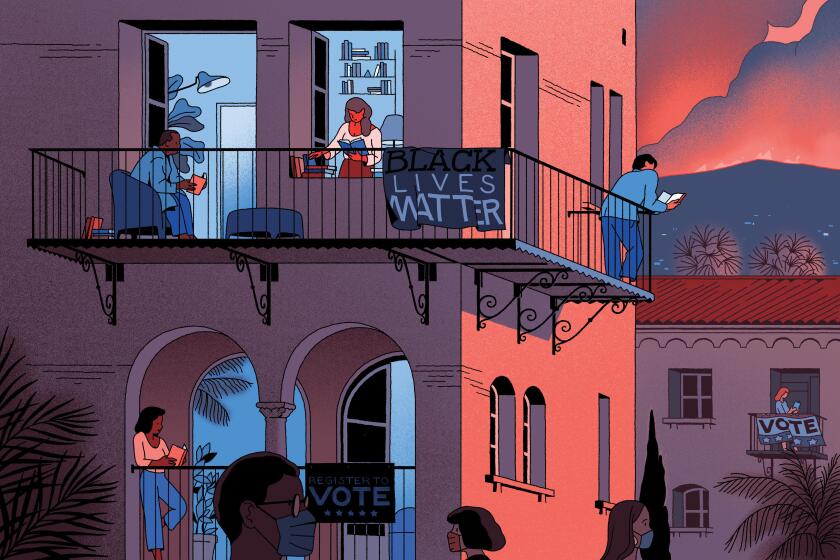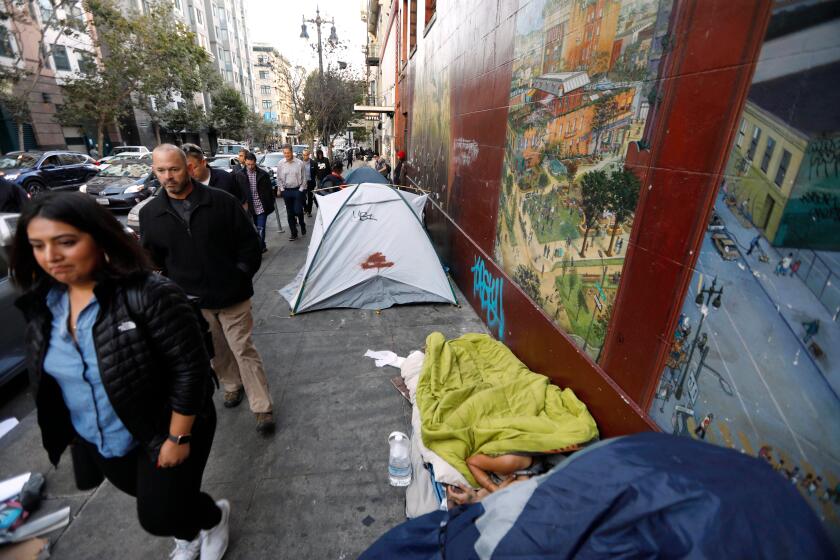Review: What we got wrong in the fog of MAGA about the white working class
On the Shelf
The Riches of This Land: The Untold, True Story of America's Middle Class
By Jim Tankersley
PublicAffairs: 320 pages, $28
If you buy books linked on our site, The Times may earn a commission from Bookshop.org, whose fees support independent bookstores.
In July 1969, in a bar with a black and white television, Bob Thompson watched Apollo 11 land on the moon. One of 25,000 workers at a North American Rockwell aerospace plant, he had played a small part, spraying foam on the command module.
Nursing a longneck Bud, “Bob was thinking about the moon,” writes Jim Tankersley in his book, “The Riches of This Land.” “Kings and queens and Jesus Christ himself. They all stared up at that moon. And when the time finally came for people to make the trip to that moon, nearly 240,000 miles from surface to surface, it started right here. In Downey, California.”
Half a century later, Tankersley, a Washington-based journalist, finds Thompson, 77, at a small hut housing the Downey Historical Society, answering schoolchildren’s questions about what it was like to build flying machines at the long-shuttered plant.
What they weren’t asking is how, with just a high school degree, Thompson managed to land a well-paying job, buy a house and retire with a pension — the basic trappings of the middle class so few of their parents can now enjoy without a college education.
Perhaps no other medium has better helped us process 2020. Our fall books special brings you the books and authors who’ve helped make sense of it.
Tankersley’s book, somewhat grandly subtitled “The Untold, True Story of America’s Middle Class” takes us on a road trip. It starts in his childhood home in Yamhill County, Ore., where loggers and mill workers were thrown out of work by automation and new forest management rules. It winds through Ohio, where manufacturing was decimated as executives exported jobs to nonunion factories in Southern states and low-wage countries such as Mexico and China.
Along the way, besides Downey’s aerospace retiree, we meet a Black father in Winston-Salem, N.C., who juggles two full time jobs as a highway construction worker and a ballpark janitor; a Mexican immigrant hairdresser in Chicago who lost her home in the Great Recession; and the feminist founder of a boutique venture capital firm in Manhattan.
Much of Tankersley’s account parallels a well-worn path of explainers on how Donald Trump eked out his 2016 election victory by fanning the fears of white blue-collar workers in swing states.
But the book also lays out a persuasive case that the analysis was distorted by white politicians, business leaders and their media enablers. And there lies a lesson for the 2020 election as the economy staggers under the COVID-19 pandemic and racial tensions erupt.
In 2016, the nation’s disillusioned voters were not just white, but also Black and Latino. And the failure of many of those voters to show up at the polls in battleground states such as Michigan was largely overlooked by journalists, Tankersley contends.
Coverage data in 2016 reveals “a clear and damning picture of the attention news organizations showered on working-class white Americans, to the exclusion of workers of color,” he writes. “We whitewashed the middle class.”
Steven Greenhouse’s”Beaten Down, Worked Up” tells the story of ongoing labor battles in America.
Tankersley’s thesis: Saturation publicity for Trump’s us-against-them rhetoric, from the Obama birther myth through the smearing of Mexican immigrants and the demonization of Muslim refugees, fueled white voters’ “government by grievance mentality.”
Meanwhile, economic studies showing how Blacks, Latinos and immigrants contributed to the post-World War II middle class — boosting the prosperity of whites along the way — were mostly ignored.
For corporations that have crippled unions giving workers a collective voice, even as executive pay and benefits skyrocketed, Trump’s divisive strategy, echoed by other Republicans, was convenient.
“Ruling elites,” Tankersley writes, “convinced one group of distressed workers to blame their troubles on another group of distressed workers. They have taken little responsibility for the policies they have pushed that hurt working families, killing jobs and stifling wage growth.”
Economic data can be eye glazing, but Tankersley weaves it into compelling portraits of human suffering and resiliency. Start with this: Bob Thompson, the aerospace retiree, is no outlier. Even today, about one in three American workers has no formal education beyond high school. That’s 46 million people.
And what’s happened to those workers over time?
From 1979 to 2018, according to calculations by the Congressional Research Service, wages rose by 14.4% for a typical American college graduate with a bachelor’s degree, after adjusting for inflation. For workers who earned no higher than a high school diploma, wages fell, by 12.3%.
And yet, Tankersley reports, “an entire class of economic thinkers in Washington kept churning out research papers about how, actually, those workers were doing just fine. They had PlayStations!”
Wage inequality has risen more in California cities than in the metropolitan areas of any other state, with seven of the nation’s 15 most unequal cities located in the Golden State.
Are white blue-collar workers worse off than everyone else? He cites Marianne Wanamaker, a University of Tennessee economic historian and former member of Trump’s Council of Economic Advisers, whose research found that Black men have experienced no gains in relative economic mobility since the 1870s. That’s no typo. 1870s.
“The Riches of This Land” dwells at length on the economic plight of Black Americans, 13.4% of the U.S. population, and chronicles the travails of a multigenerational African American family across several chapters. But most of the book’s race-related statistics make no mention of Latinos, 18.5% of the U.S. population, and its account of a Mexican American family is cursory.
That may be understandable as the Black Lives Matter movement dominates headlines. But in California, where Latinos make up nearly 40% of the population, one can’t help but wonder: Why the blind spot?
Readers seeking more depth about how corporations have suppressed wages and benefits for the working class may want to turn to Steven Greenhouse’s recent history, “Beaten Down, Worked Up.” Rick Wartzman’s account of businesses pivoting to a singular focus on shareholders over their employees and their communities, “The End of Loyalty,” also offers the kind of in-the-trenches reporting that is lacking in “The Riches of This Land.”
But where Tankersley excels, as we face another its-the-economy-stupid election, is in parsing data on America’s ailing middle class and leavening it with sympathetic portraits. As much as anything, he seeks to refute Trump’s xenophobic, white-centered and misguided vision of how to make America great.
Eula Biss’ last collection, “On Immunity,” exposed our society’s fragile health. “Having and Being Had” takes on capitalism (and defends Joan Didion).
More to Read
Sign up for our Book Club newsletter
Get the latest news, events and more from the Los Angeles Times Book Club, and help us get L.A. reading and talking.
You may occasionally receive promotional content from the Los Angeles Times.










